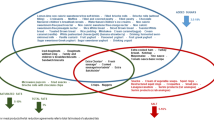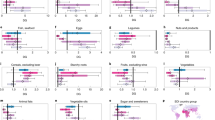Abstract
A number of approaches have been initiated by governmental and public health organizations in different countries to reduce trans-fatty acid (TFA) intakes. These have included nutrition recommendations with regard to TFAs and general nutrition recommendations regarding the selection of healthy fats, programmes to raise awareness about the adverse effects of TFAs through nutrition and health claims, voluntary or mandatory labelling of the trans content of foods, voluntary or legislated programmes to encourage or force industry to reformulate food products to remove TFAs, the promotion of health and agricultural policies that encourage the production of healthy alternatives to trans fat and finally, mandatory regulation of food standards to remove or reduce the TFA content. This paper reviews a number of initiatives to reduce the intake of TFAs underway in selected industrialized and developing countries, which serves to illustrate the merits and limitations of the available options and how the approaches that have been taken reflect local conditions.
This is a preview of subscription content, access via your institution
Access options
Subscribe to this journal
Receive 12 print issues and online access
$259.00 per year
only $21.58 per issue
Buy this article
- Purchase on Springer Link
- Instant access to full article PDF
Prices may be subject to local taxes which are calculated during checkout





Similar content being viewed by others
References
Achaya KT (1987). Fat status of Indians—a review. J Sci Ind Res 46, 112–126.
Davignon J, Holub B, Little JA, McDonald BE, Spence M (1980). Report of the Ad Hoc Committee on the Composition of Special Margarines. Ministry of Supply and Services Canada: Ottawa.
Debeza A, Sissu E, Gulayin R, Espeche M, Peterson G, Cavallero E et al. (1999). Composition of fatty acids from triglycerides of adipose tissue in subjects with no coronary atherosclerosis. RNC Sci Pub Clin Nutr 8, 52–55.
Eckel RH, Borra S, Lichtenstein AH, Yin-Piazza SY (2007). Understanding the complexity of trans-fatty acid reduction in the American diet. American Heart Association Trans Fat Conference 2006: Report of the Trans Fat Conference Planning Group. Circulation 115, 2231–2246.
FAO (1994). Fats and Oils in Human Nutrition. Report of a Joint FAO/WHO Expert Consultation. FAO Food and Nutrition Paper No. 57. Food and Agriculture Organization of the United Nations: Rome.
Food and Drug Administration (2003). Food Labeling: Trans Fatty Acids in Nutrition Labeling, Nutrient Content Claims, and Health Claims. FDA: Washington, DC.
Friesen R, Innis SM (2006). Trans-fatty acids in human milk in Canada declined with the introduction of trans fat food labeling. J Nutr 136, 2558–2561.
Ghafoorunissa (1996). Fats in Indian diets and their nutritional and health implications. Lipids 31 (Suppl), S287–S291.
Ghafoorunissa (1998). Requirements of dietary fats to meet nutritional needs and prevent the risk of atherosclerosis—an Indian perspective. Indian J Med Res 108, 191–202.
Ghafoorunissa, Vani A, Laxmi R, Sesikeran B (2002). Effects of dietary alpha-linolenic acid from blended oils on PUFA nutritional status and biochemical indices of coronary heart disease in Indians. Lipids 37, 1077–1086.
Health Canada (2003). Regulations Amending the Food and Drug Regulations (Nutrition Labelling, Nutrient Content Claims and Health Claims)—12 December 2002. Canada Gazette 137, 1. At http://canadagazette.gc.ca/partII/2003/20030101/html/sor11-e.html (accessed 8 January 2008).
Health Canada (2007a). Canada's Food Guide: Eating Well with Canada's Food Guide. Health Canada: Ottawa. At http://www.hc-sc.gc.ca/fn-an/food-guide-aliment/index_e.html (accessed 8 January 2008).
Health Canada (2007b). Trans Fat Monitoring Program. Health Canada: Ottawa. At http://www.hc-sc.gc.ca/fn-an/nutrition/gras-trans-fats/tfa-age_tc-tm_e.html (accessed 8 January 2008).
Health and Welfare Canada (1990). Nutrition Recommendations—The Report of the Scientific Review Committee. Supply and Services Canada: Ottawa.
Jacobsen MU, Bysted A, Andersen NL, Heitmann BL, Hartkopp HB, Leth T et al. (2006). Intake of ruminant trans-fatty acids in the Danish population aged 1-80 years. Eur J Clin Nutr 60, 312–318.
Jeyarani T, Reddy YS (2005). Physiochemical evaluation of vanaspati marketed in India. Central Food Technological Research Institute (CFTRI). J Food Lipids 12, 232–242.
Katan MB (2006). Regulation of trans fats: the gap, the polder, and McDonalds French fries. Atheroscler Suppl 7, 63–66.
Kheiri MSA (1982). A Survey of Indian and Pakistani Vanaspati Products. PORIM Occasional Paper No. 5 ISSN: 0127-2209. Palm Oil Research Institute: Malaysia.
Leth T, Jensen HG, Mikkelsen AA, Bysted A (2006). The effect of the regulation on trans-fatty acid content in Danish food. Atheroscler Suppl 7, 53–56.
Mehta BV (2007). Demand-supply of vegetable oils in India. Paper presented at SCODET Asia. At http://www.seaofindia.com/articles_bvmehta-SCODET%20ASIA%202007.html (accessed 8 January 2008).
National Institute of Nutrition (2000). National Institute of Nutrition Annual Report, India (1999–2000). NIN: Hyderabad. At http://www.icmr.nic.in/annual/nin.pdf (accessed 10 January 2008).
National Sample Survey (2001) Report 46: Consumption of some important commodities in India (1999–2000). 55th Round National Sample Survey Organisation, Government of India, July 2001.
New York City Department of Health and Mental Hygiene (2007a). Healthy Heart—Avoid Trans Fat. At http://www.nyc.gov/html/doh/html/cardio/cardio-transfat.shtml (accessed 8 January 2008).
New York City Department of Health and Mental Hygiene (2007b). Trans Fat Help Centre. At http://www.citytech.cuny.edu/notransfatnyc/english/frying.html (accessed 8 January 2008).
Okie S (2007). New York to trans fats: you’re out!. N Engl J Med 356, 2017–2021.
PAHO/WHO Task Force (2007). Trans Fats Free Americas Conclusions and Recommendations. Pan American Health Organization: Washington.
Peterson G, Aguilar D, Espeche M, Mesa M, Jáuregui P, Díaz H et al. (2004). Trans-fatty acids in food consumed by youth in Argentina. Pediatr Argentine Arch 102, 102–109.
Rastogi T, Reddy SK, Vaz M, Spiegeiman D, Prabhakaran D, Willett WC et al. (2004). Diet and risk of ischemic heart disease in India. Am J Clin Nutr 79, 582–592.
Ratnayake WHN, Chen ZY (1995). Trans-fatty acids in Canadian breast milk and diet. In: Przybylski R, McDonald BE (eds). Development and Processing of Vegetable Oils for Human Nutrition. AOCS Press: Champaign. pp 20–35.
Ratnayake WMN, Gagnon C, Dumais L, Lillycrop W, Wong L, Meleta M et al. (2007). Trans-fatty acid content of Canadian margarines prior to mandatory trans fat labelling. J Am Oil Chem Soc 84, 817–825.
Singh S, Mulukutla P (1996). Consumer behaviour in food products: a case study in edible oils in urban India. Indian Food Industry 15, 34–42.
Solvent Extractors Association (2005a). SEA Handbook on Indian Vegetable Oil Industry and Trade. Section 17, Vanaspati Industry. pp 626–663.
Solvent Extractors Association (2005b). Per capita availability of certain important articles of consumption. Vegetable Products (2)/99 dated 21 April 2003. At http://indiabudget.nic.in/es2001-02/chapt2002/tab119.pdf (accessed 10 January 2008).
Solvent Extractors Association (2007). Solvent Extractors Association News Circular, vol X, issue 7, pp 78, October 2007. At http://www.seaofindia.com (accessed 9 January 2008).
Srinivasan P (2005). Impact of trade liberalization on India's oilseed and edible oil sector. Report prepared for IGIDR-ERS/USDA Project: Indian Agricultural Markets and Policy, February 2005.
Stender S, Dyerberg J (2001). Transfedtsyrers betydning for sundheden. Opdatering år 2001. A Report from The Danish Nutrition Council, Publication No. 23. Danish Nutrition Council: Copenhagen.
Stender S, Dyerberg J (2003a). Transfedtsyrers betydning for sundheden. Opdatering 2003. A Report from The Danish Nutrition Council, Publication No. 29. Danish Nutrition Council: Copenhagen.
Stender S, Dyerberg J (2003b). The Influence of Trans Fatty Acids on Health, 4th edn. A Report from The Danish Nutrition Council, Publication No. 34. Danish Nutrition Council: Copenhagen.
Stender S, Dyerberg J, Hølmer G, Ovesen L, Sandström B (1994). Transfedtsyrers betydning for sundheden. A Report from The Danish Nutrition Council, Publication No. 2. Danish Nutrition Council: Copenhagen.
Tavella M, Peterson G, Espeche M, Cavallero E, Cipolla L, Perego L et al. (2000). Trans-fatty acid content of widely consumed foods in Argentina. Food Chem 69, 209–213.
Tavella M, Pilone P, Bruno M, Patalagoyty S, Navas H, Sicalo D, on behalf of the DEMOBAL Working Group (2001). DEMOBAL, National Demonstration Project Balcarce, Province of Buenos Aires, Argentina. Program for the Prevention of Infarct (PROPIA), Universidad Nacional de La Plata. First National CDC Prevention Conference on Heart Disease and Stroke; 22–24 August; Atlanta, GA, USA Prevent Med 33, S14.
Tavella M, Spadafora S (1997). The Program for the Prevention of Infarcts in Argentina. Worldwide Efforts to Improve Heart Health. A Follow-up to the Catalonia Declaration. CDC: Atlanta. p S55.
Trans Fat Task Force (2006). Report of the Trans Fat Task Force. TRANSforming the Food Supply. Health Canada: Ottawa. At http://www.hc-sc.gc.ca/fn-an/nutrition/gras-trans-fats/tf-ge/tf-gt_rep-rap_e.html (accessed 8 January 2008).
Valenzuela A, Nieto S, Peterson G, Tavella M (2004). Comparative study in fried food about the stability of different vegetable oils. Fat Oils Mag 2, 22–28.
WHO (2003). Diet, Nutrition and the Prevention of Chronic Diseases. Report of a Joint WHO/FAO Expert Consultation. WHO Technical Report Series No. 916. World Health Organization: Geneva.
WHO (2004). Global Strategy on Diet, Physical Activity and Health. Resolution of the World Health Assembly. Fifty-seventh World Health Assembly. WHA57.17. World Health Organization: Geneva.
Willett WC, Stampfer MJ, Manson JE, Colditz GA, Speizer FE, Rosner BA et al. (1993). Intake of trans-fatty acids and risk of coronary heart disease among women. Lancet 341, 581–585.
Acknowledgements
The authors express their thanks to Dr Jillian Boreham for providing Figure 4. The authors also thank Dr Dariush Mozaffarian, Dr Srinath Reddy and Professor Ricardo Uauy for their valuable peer-review comments on the draft manuscript.
Author information
Authors and Affiliations
Corresponding author
Rights and permissions
About this article
Cite this article
L'Abbé, M., Stender, S., Skeaff, C. et al. Approaches to removing trans fats from the food supply in industrialized and developing countries. Eur J Clin Nutr 63 (Suppl 2), S50–S67 (2009). https://doi.org/10.1038/ejcn.2009.14
Published:
Issue Date:
DOI: https://doi.org/10.1038/ejcn.2009.14
Keywords
This article is cited by
-
Binary Phase Behavior of 2-oleoyl-1-palmitoyl-3-stearoyl-rac-glycerol (POS) and 2-linoleoyl-1-palmitoyl-3-stearoyl-rac-glycerol (PLS)
Food Biophysics (2023)
-
Children’s Influence on Parents: the Bidirectional Relationship in Family Meal Selection
Journal of Child and Family Studies (2023)
-
Novel Full Hydrogenation Reaction of Methyl Esters of Palm Kernel and Sunflower Oils Into Methyl Stearate Catalyzed by Rhodium, Ruthenium and Nickel Complexes of Bidentate Hexasulfonated o-Phenylendiphosphite Ligands
Catalysis Letters (2019)
-
Food reformulation and nutritional quality of food consumption: an analysis based on households panel data in France
European Journal of Clinical Nutrition (2018)
-
Determination of Double Bond Positions and Geometry of Methyl Linoleate Isomers with Dimethyl Disulfide Adducts by GC/MS
Lipids (2016)



